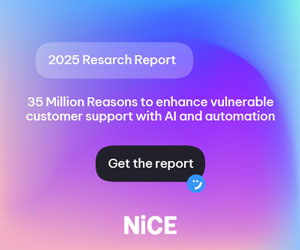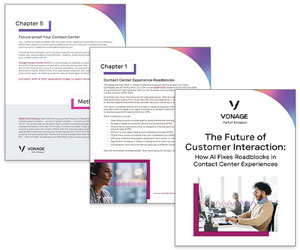Our panelists discuss the common mistakes that contact centres often make, before sharing how they would recommend solving the issue.
1. Ignoring Quality and Feedback Biases
Effective quality and feedback strategies are such elementary aspects of delivering contact centre improvement that it is surprising how often organizations get this badly wrong.
Ways of capturing feedback are imperfect. For example, how can you make sure you get a balanced view at all levels, i.e. interaction, journey and brand? Who owns the feedback at each level and how is the data disseminated and acted on?
Quite often we see the post-call survey or the “How did we do today?” question as the quintessential feedback channel, but the way we capture that can be fundamentally flawed.
Quite often we see the post-call survey or the “How did we do today?” question as the quintessential feedback channel, but the way we capture that can be fundamentally flawed.
Where it is an agent-offered survey, we can be sure there is a bias to where surveys are promoted, and the IVR/messaging method of “opting in” before an interaction yields such low uptake and is often seen as an inconvenience by customers and can detract from your CSAT in itself.
Even when feedback is done well, how is your organization dealing with it by being proactive? The point is that quality and feedback should continue to be fundamental to your operation, but you need to get smarter at ways of capturing feedback and measuring quality.
2. Prioritizing the Customer Experience Over the Employee Experience
So much discussion in recent years has been around understanding customer journeys and orienting tools and processes around improving customer experiences.
But it is surprising how few organizations have applied those same principles to employee journeys to improve employee experience.
There is an opportunity to look closely at employee journeys and think about solutions to ease the burden. Sometimes just simple things can make a big difference, like providing self-service tools for holiday booking or shift changes.
We should look after our employees and they will take care of our customers… There is an inextricable link between customer experience and employee experience.
Richard Branson is credited with saying that we should look after our employees and they will take care of our customers, and that must surely be true. There is an inextricable link between customer experience and employee experience.
Perhaps one way to improve the experiences of our employees would be to focus more of our resources on analysing and addressing the friction that exists in our employee journeys so that, in return, we see more motivated teams going the extra mile for our customers.
3. Failing to Communicate Between Departments
Hands up anyone who thinks their organization does a good job of effectively communicating between teams… Anyone? The reality is that doing this well, and consistently, is a rare feat.
However, it is good for all of us to educate, inform and bring our colleagues around the organization along with us on improvement initiatives – particularly where they can help or hinder.
This starts with a really clear vision and roadmap, which is subscribed to by all teams, with a mutual understanding of why and how it will be achieved.

This starts with a really clear vision and roadmap, which is subscribed to by all teams, with a mutual understanding of why and how it will be achieved.
All too often, great ideas have cold water poured on them after the contact centre has put huge amounts of time and effort into developing them, meeting suppliers, building investment cases, etc.
The same should be true in reverse – that is, where initiatives and projects are misaligned with top-level business goals then they can run aground.
In order for ideas, initiatives and projects to gain real momentum, we need to ensure the whole organization is bought into what we are doing!
4. Keeping Advisors Removed From Top-Level Business Objectives
In many contact centres, agent metrics might as well be carved in stone. They have been the measure of operational performance since the dawn of time; but we all know that many metrics can seem arbitrary or even conflicting to our agents.
So, what difference does it make when agents are completely put in the picture about ‘why’ those metrics are set?
Advisors who feel more engaged with what they are doing and understand why those metrics are important for the business show greater positivity.
The research tells us that advisors who feel more engaged with what they are doing and understand why those metrics are important for the business show greater positivity.
Conversely, if agents are measured against punitive metrics without any understanding of why, they are more likely to become disengaged.
So, shine some light their way and help them understand why Average Handling Time (AHT) ultimately supports your efficiency initiative or why the company growth boils down to the team’s call-to-quote ratio!
5. Storing Customer Information in Multiple Places
One of the biggest issues in many contact centres is the availability of the information advisors need in order to effectively serve customers.
Even the worst offending organizations must surely recognize that expecting advisors to browse an intranet, two SharePoint sites, three separate systems and a 150-page printed directory of numbers in order to resolve a customer query is likely to cause frustration.
Expecting advisors to browse an intranet, two SharePoint sites, three separate systems and a 150-page printed directory of numbers in order to resolve a customer query is likely to cause frustration.
There are so many great ways to use technology to address this prevalent problem, including smart knowledge-base tools, sophisticated ways to pass agents information about the context of a customer journey, the customer’s contact or shopping history, lifetime customer value, etc.
The impact this has on your advisors’ ability to do a good job cannot be overestimated. Empower your agents by giving them the information they need.
6. Failing to Manage Customer Data
Obtaining, organizing and harnessing data is a real challenge, so it is no wonder that this is such a struggle for so many contact centres.
We all need timely, reliable and accurate data to make effective decisions that affect the day or the month or even the long-term strategy.
Disparate and siloed systems do not help. Nor does a worryingly heavy reliance on one person who knows the dark art of extracting and manipulating data in spreadsheets full of formulae, macros and SQL.

Adam East
We need to think carefully about the thing we are trying to measure, the insight we want or the problem we are trying to solve, in order determine where the data resides, how we can best obtain the data and then where we process it.
There are lots of traps we could fall into when doing this which lead to inaccuracy or misinterpretation, but there are some great methodologies, technologies and experts on hand these days to help, so it may be worth some external support.
Thanks to Adam East at Noble Systems
7. Implementing Artificial Intelligence (AI) Without Careful Consideration
As contact centres progress into the future and try to adopt new ways of working, there is a focus on new tools to deliver forward-thinking solutions.
There are many genuinely capable machine learning tools, but they can be drowned out by the noise of less capable products claiming there are elements of AI at their core, when that is not true.

Alex Fleming
The same can be said for chatbot solutions, and while their popularity is rising, contact centres need to be conscious of their actual capabilities.
Chatbots simply do not fulfil the basic KPIs of delivering a quality of service that means callers do not need to engage with advisors for some of their requests or issues.
Thanks to Alex Fleming at Speechmatics
8. Not Saying Sorry
Many organizations still fail to make the act of apologizing a core behaviour. The CallMiner Churn Index showed that to stay loyal, almost half (42%) of consumers want suppliers to apologize when the service is not satisfactory.
Saying sorry has been proven to make a big difference. A further study by the University of Nottingham shows that apologies get better responses than financial compensation.
In fact, this research found that double the number of people who had posted a negative comment about a service (45%) withdrew it when they received an apology than those who were offered financial compensation to remove it (23%).
Double the number of people who had posted a negative comment about a service (45%) withdrew it when they received an apology than those who were offered financial compensation to remove it (23%).
However, there is also a danger in offering a less than sincere apology, as that too can leave a negative impression on the customer.
So, remember the keys to making a genuine apology. This includes understanding what you are apologizing for first, then saying sorry, before showing real empathy.
9. Overlooking the Importance of Listening to Customers
When asked about their emotional state before a call to a call centre, the top response by almost half of consumers (46%) is that they just want someone to listen to them. However, only half that number (23%) reported they felt ‘listened to’ after the call.
This CallMiner research shows that a worrying number of contact centre advisors aren’t demonstrating to their customers that they are listening to them.
Advisors should be reminded that, while to them it may just be another call, to the customer it may mean everything.
So, coach team leaders to help advisors reframe their mind between calls. Advisors should be reminded that, while to them it may just be another call, to the customer it may mean everything.
In addition, it can be good to use real-time analytics to guide your advisors so they use active listening on every call, while you can also drive improvement by creating an “empathy” score to measure each agent’s listening ability and feature this on advisor scorecards.
10. Assuming Happiness at Certain Parts of the Customer Journey
Many organizations have systems in place to capture feedback at certain points on the customer journey.
But a good satisfaction rating or Net Promoter Score at one point on the journey does not necessarily mean that the customer is happy.
- Was the customer happy before a bad experience?
- Has the satisfaction level changed after you made up for a bad experience?
- Do you understand the true “voice of the customer” based on the entire experience?

Frank Sherlock
These are all important, but we cannot assume that all customers will be feeling one way because they have reached a certain part of their journey.
This is key, and we also need to guard against guessing what the customer journey looks like by only analysing a small percentage of customer interactions. We need to be more thorough in our trend spotting.
Thanks to Frank Sherlock at CallMiner
For more on why you should be wary of assuming too much from customer journey maps, listen to the episode of The Contact Centre Podcast, with Sandra Thompson.
The Contact Centre Podcast – Episode 12:
Customer Experience: The New Thinking For Delighting Your Customers
For more information on this podcast visit Podcast – Customer Experience: The New Thinking for Delighting Your Customers
11. Failing to Quantify the Business Case for New Technology
Technological developments – such as AI, machine learning, real-time analytics and omnichannel analysis – are being implemented by an increasing number of contact centres.
While these innovations have the potential to significantly increase efficiency and offer new business insights, it is critical for companies to consider how each of these technologies impacts performance.
Whether looking at KPIs such as cost, customer satisfaction or revenue, organizations must evaluate each innovation in terms of how it will contribute to the desired business outcomes.
Without this consideration, technology can easily end up being underutilized regardless of how great its potential may be.
12. Underestimating the Internal Resources Required to Deploy New Technology
While most technology vendors are experts in deploying their solutions, there are certain areas that must be owned internally for a solution to be most effective.
Some of these areas include:
i. Internal change management and organization design: Companies must have a process in place to prepare the contact centre to accept and operationalize the new technology. The process should include a plan to oversee changes in people, procedure and measures of success.
ii. Dedicated analysts and product experts: Businesses need to dedicate internal resources to the care and maintenance of any new systems following initial deployment to ensure long-term success.
iii. Subject-matter experts: Individuals must be available to provide support to various lines of business in order to ensure that the solution is reaching its fullest potential. These experts are also able to make sure the new technology aligns with real and evolving pain points in the organization.

Shorit Ghosh
iv. Project managers: It’s necessary to identify the employees who will be responsible for coordinating between the technology vendor and internal stakeholders during and after the deployment process.
v. Executive management: Without executive buy-in, it’s extremely difficult to guarantee that new technology will be successfully implemented at an enterprise-wide level. Lack of proper adoption can result in failure to see ROI over time.
Thanks to Shorit Ghosh at Clarabridge
13. Using Outdated Call-Routing Strategies
Some modern customers expect companies to know that they have already engaged with them. Contact centres failing to meet these demands are on the road to creating detrimental customer experiences.
Naturally, not all businesses are equipped to be ‘always on’. But even if you can’t respond to queries 24/7, what you can do is ensure a coherent strategy across each channel to make sure returning customers are being dealt with in the right way.
With this in mind, it is great for contact centres to ensure agents have information from previous interactions available, so that they have a complete view of the customer and the query they’re dealing with.

Sunny Dhami
This can be facilitated by technology that is capable of routing a customer to the advisor they were previously dealing with, or that can give advisors prompts so they remember to say certain things or reference previous interactions at a particular moment in the conversation.
When advisors are equipped to do this, conversations feel more personal, regardless of the channel the customer is using.
Thanks to Sunny Dhami at RingCentral
14. Using Huge Spreadsheets as a Quality Assurance (QA) Tool
If you are using spreadsheets, you already know that they are not the tried-and-tested method that some contact centre managers think.
You could actually be losing efficiency, productivity, quality, and revenue in the long run due to inaccuracies and limitations in forecasting, monitoring, and data integrity. Not to mention the potential for human error!
Spreadsheets are a generic tool that that is not designed for high-volume data gathering and categorization, which are essential to your QA success.

Dick Bourke
Instead, specialist QA tools can help. Designed by experts, these tools help you to streamline your QA process to reveal new opportunities for improvement.
Also, these tools help you to collect, analyse, report and then make decisions on your data, quickly and accurately, which is essential to contact centre management.
Thanks to Dick Bourke at Scorebuddy
15. Failing to Remove Distracting Background Noise
Every time a customer interacts with you, they want to feel they have your undivided attention. On a voice call, advisors need to be able to focus on what matters most – the conversation.
Too often, advisors are using headsets that don’t block out the ambient noise that is commonplace in contact centre environments. Both advisors and customers struggle to focus as background sounds impact the experience.

Richard Kenny
Best-in-class headsets provide a premium experience, offering all-day comfort, built-in call control, advanced audio processing and noise-cancelling microphones to block out ambient office noise.
Certain modern headsets come with an extendable microphone that ensures precise positioning to help ensure customers hear every word, offering enhanced comfort and durability so advisors can provide outstanding service all day, every day.
Thanks to Richard Kenny at Poly
16. Installing Technology for Technology’s Sake
New technologies are arriving at lightning speed and the hype around them is enough to make the most rational of contact centres rush in for fear of being left behind.
Make new technology relevant and think primarily about the conversations that you have with customers.
Don’t be lured by the latest “hot thing” just because everyone else is apparently using it. Instead, make new technology relevant and think primarily about the conversations that you have with customers.
Then, become a mystery shopper yourself and try out the contact centre to discover the channels and technology that really matter.
Longer-term, you’ll invest in the right technology and your agents and customers will thank you for your patience.
17. Providing Advisors With Messy Screens
With advisors constantly having to switch between applications to get customers the answers they need, first time around and in the channel of their choice, there is often too much clutter on advisors’ screens.
The trouble is messy screens lead to messy minds and slower response times, so we want to concentrate on how we can make life easy for advisors.
Messy screens lead to messy minds and slower response times, so we want to concentrate on how we can make life easy for advisors.
To do this, it is good to focus on the user interface (UI) and take advantage of the latest advisor applications. Some of these are complex AI solutions.
With these solutions, advisors have the power to gather relevant information from previous enquiries, such as activity history and complete case notes, as well as the ongoing request to suggest responses of the first-time fix variety.
18. Failing to Actively Manage Knowledge
Some organizations instil a climate of fear and unhealthy competition where having knowledge but not sharing it is to have power.
Eradicate this kind of negative siloed mentality and encourage contact centre staff to collaborate with each other and the rest of the organization.

Thomas Rødseth
With the right mindset where advisors openly share knowledge, tips and learning, contact centres are well placed to become the trailblazers of first-class customer service.
One way to create such a culture is to involve advisors in developing knowledge articles for the knowledge base, which should be actively reviewed and updated, to ensure consistency of information across channels.
Thanks to Thomas Rødseth at Puzzel
19. Neglecting the Importance of Making Your Team Feel Valued
Employee retention has been a fundamental contact centre challenge for a long time, but still contact centre annual attrition rates rarely fall below 50%.
There are normally a number of closely related factors that can cause loss of commitment here, with a less than supportive corporate culture often at the centre of it all.
What can you do in order to boost employee retention? First, try to ensure employees feel valued. This starts with managers communicating their message sincerely in order to be heard and believed.
Next, ask yourself, how are we investing in our people? Have we offered the team great new technology? Have we improved the work environment? Where are we on training?

Neil Draycott
Think outside the box, too – gamification approaches can help promote cohesion and a fun work environment that stimulates and motivates employees.
Also, don’t forget about your resource planning, making it convenient for advisors to check work needs, request shift changes, book annual leave and giving them the flexibility to organize their lives around their work commitments.
Thanks to Neil Draycott at Business Systems
20. Failing to Modernize Old Telephony and IVR Systems
One of the biggest mistakes leading to the current disconnect between brands and their customers is that companies are not capturing and taking advantage of the masses of data that passes through their contact centres.
If businesses want to keep up with rising consumer expectations, it is great for their contact centre to have access to an intelligent telephony platform.
These systems can efficiently collect data and provide advisors with a 360-degree view of the caller, as well as insights from all their previous interactions. This will enable businesses to provide the personalized experience that today’s customers expect.

Neil Hammerton
Another example of how an intelligent telephony platform can drive personalization is by making IVR far more dynamic.
Through a dynamic IVR, brands can present callers with specific options that are relevant to them based on the available data, meaning customers won’t be left listening to ten alternatives before getting to the one they need.
Doing so will reduce the time it takes to solve an issue, ultimately increasing customer satisfaction.
Thanks to Neil Hammerton at Natterbox
21. Isolating the Front and Back Office
Organizations can improve business performance and deliver a better experience by deepening their understanding of the consumer across the entire customer journey life cycle.
Back-office digitization is an effective way to maximize your consumer engagement budget, while merging front and back office will help retain the digital customer.
The problem is that too many Chief Information Officers (CIOs) have not put the work in to blending the front and back office because it seems too challenging.

Helen Berry
Issues that tend to raise worries range from the cultural to the operational, but real-world experience tells us that these issues are very soluble – they just require careful transformation planning.
To help, look to the latest workforce optimization (WFO) technology out there, as it can provide the right tools and functionality to smoothly integrate front- and back-office processes for you.
Thanks to Helen Berry at Business Systems
22. Implementing Multiple CRM Systems
Customers have gone digital and businesses are scrambling to keep up. In the process, they are creating new silos of digital interactions, whether it be a standalone chatbot or messaging app or social app.
Contact centres will ideally make sure that all the digital channels they are adding are connected to the same CRM platform for a connected customer (and advisor) experience.

Anand Subramaniam
Otherwise, they will be perpetually busy integrating disparate digital engagement systems, an activity that deletes business value instead of adding it!
To do this, investigate whether CRM functionality is deep and provides quick business value out of the box or whether it would take months or even years of programming and customization to deliver the capability.
Thanks to Anand Subramaniam at eGain
23. Analysing Too Few Contacts to Confidently Spot Trends
With the industry ever changing, as more contact centres are moving towards digital adoption, it can be difficult to know if you are facing every new challenge with best practices in mind.
While the ability for customers to reach you on the channel of their choice is fantastic for the customer experience, it can be a detriment if you are not analysing 100% of those interactions for your benefit.

Shawna Malecki
It’s great to not only gather all of your interaction data, but also have a solution in place to provide insights from that collective data to make improvements to your organization.
Using an interaction analytics solution will allow you to make the most of your investment in omnichannel by providing the full picture of what’s happening in your call centre, including discovering trends, issues and levels of customer satisfaction.
Thanks to Shawna Malecki at NICE inContact
24. Thinking About Channels Separately
Today’s customers don’t think about channels. They expect to be able to access an advisor in whichever way is most convenient to them…
Today’s customers don’t think about channels. They expect to be able to access an advisor in whichever way is most convenient to them – whether that’s by phone or email, via social media or using live chat.
If you’re not providing effective, joined-up customer service across a range of channels, your customers may be dissatisfied before even reaching an advisor.
The solution here is to adopt an omnichannel approach that allows customers to access support in the way they prefer. This enables advisors to retrieve detailed and personalized information irrespective of which channel the customer is using.
25. Disregarding Gaps in Your IVR
While most consumers prefer to speak to a real person when seeking customer service, many are reluctant to pick up the phone.
Why? According to research, 26% hate not being able to speak to a person and 25% dislike having to repeat the same information to multiple agents.

Tim Kimber
Invest in a system that enables customers to call your organization, input the necessary information, then be directed to the customer service department best able to meet their requirements. This minimizes wait times, reduces the need to be passed between multiple agents, and increases satisfaction.
IVR software, for example, can help organizations that want to offer a more effective, meaningful self-service experience.
Thanks to Tim Kimber at NewVoiceMedia
26. Giving Advisors Different Tools for Different Interactions
Customers are engaging with brands across several different channels, be it voice, digital or messaging tools. However, one of the mistakes that can be made is to run a number of disparate solutions that are not synchronized.
This will lead to advisors having to flip between different systems and dashboards and not having the customer’s information follow them during the interaction.
The result of this will be an erosion of customer support, quality and frustration for the advisors as they will have to keep asking for information.
It will make setting and monitoring KPIs more difficult as information needs to be pulled from multitude different sources…
Also, it will make setting and monitoring KPIs more difficult as information needs to be pulled from multitude different sources, and the reporting capabilities may not always match.
To ensure they don’t get burdened with too many solutions, businesses will ideally be investing in a consolidated platform that allows for integrations of new channels and tools.
27. Limiting Training and Upskilling
When we are so focused on maximizing a service level in the contact centre, it is typical to postpone coaching sessions with advisors. The trouble is that this is a slippery slope.
If advisors are expected to deal with the same tasks and systems day after day, without being upskilled or having training sessions in between, it will start to eat away at the employee experience, as well as impact the level of service customers receive.

If advisors are expected to deal with the same tasks and systems day after day, without being upskilled or having training sessions in between, it will start to eat away at the employee experience…
With the proliferation of new tools and technologies available, contact centre managers need to ensure that the team receive continuous training on the processes, technologies and the types of queries they handle.
Also, contact centre managers should identify which advisors can transfer knowledge to others.
By keeping track of staff skills, managers can ensure that they have the right mix across each shift to ensure all types of customer queries can be well addressed.
28. Failing to Understand Generational Differences
For your Millennial and Generation Z (“Gen Z”) customers, the ‘one size fits’ all approach to customer experience is not enough.
These digitally native consumers are used to ordering products and services at the touch of a button and are less likely to want to wait to speak to an advisor or navigate complex IVR channels.
Digitally native consumers are used to ordering products and services at the touch of a button and are less likely to want to wait to speak to an advisor or navigate complex IVR channels.
The mistake some organizations make is that they have not evolved to ensure that they are engaging with their customers on their terms.
Businesses should ensure that they are able to answer queries across digital channels and provide deeper levels of self-service to the younger generations, so their customer service matches their shopping habits.
29. Working in Silos
Providing a unified and fluid customer experience is difficult when technology and organizational silos exist. These silos are often based on business function, product, geography, channels or other segmentations – all of which can create irreconcilable issues.
While it might be tempting to seek technology solutions to break down the technology and organizational silos, it is better for organizations to bridge them.
Any business that fails to do so and continues to operate in an environment that permits silo owners to operate independently of the overall customer experience risks getting lost in the chasm.

Nick Wingrove
To bridge these silos, businesses should be looking to assess underlying technology and organizational challenges to unify customer experience.
Communication and collaboration between different silo owners are key as this will help join up the gaps in the service.
Thanks to Nick Wingrove at Genesys
For more from our panel of experts, read our articles:
- 14 Contact Centre Problems and Solutions
- 15 Interesting Ways to Modernize Your Contact Centre
- The Top 10 Emerging Technologies in Contact Centres
Author: Robyn Coppell
Published On: 9th Dec 2019 - Last modified: 18th Oct 2024
Read more about - Call Centre Management, Anand Subramaniam, Business Systems, CallMiner, Clarabridge, Customer Service, eGain, Genesys, Natterbox, NiCE CXone, Noble Systems, Poly, Puzzel, Richard Kenny, RingCentral, Scorebuddy, Speechmatics, Tim Kimber, Vonage





















